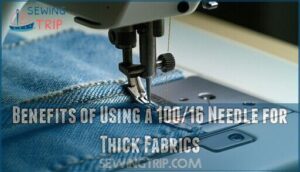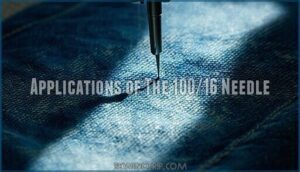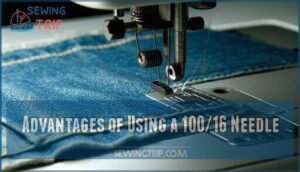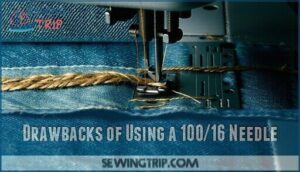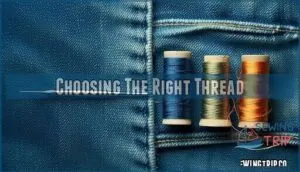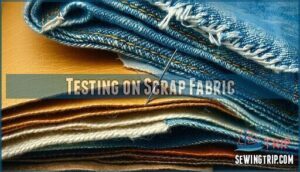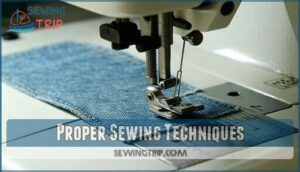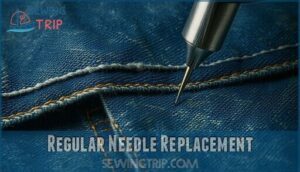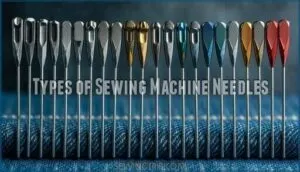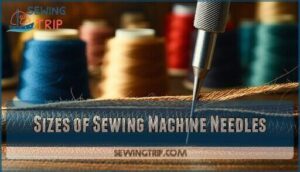This site is supported by our readers. We may earn a commission, at no cost to you, if you purchase through links.
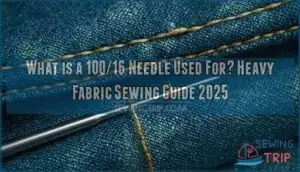
You’ll use it when working with thick fabrics like denim, canvas, upholstery materials, and multiple fabric layers.
The "100" refers to the needle’s size (equivalent to size 16 in American sizing), while the sturdy shaft easily penetrates dense materials without breaking or bending.
This needle accommodates heavier threads that lightweight needles can’t handle, making it perfect for topstitching, quilting thick batting, and creating durable seams on heavyweight fabrics.
It’s also ideal for leatherwork and home décor projects where you need extra strength and reliability.
The right needle choice can transform your sewing from frustrating to flawless.
Table Of Contents
- Key Takeaways
- What is a 100/16 Needle?
- Benefits of Using a 100/16 Needle for Thick Fabrics
- Types of 100/16 Needles
- Applications of The 100/16 Needle
- Advantages of Using a 100/16 Needle
- Drawbacks of Using a 100/16 Needle
- Tips for Using a 100/16 Needle
- Understanding Sewing Machine Needles
- Types of Sewing Machine Needles
- Sizes of Sewing Machine Needles
- Frequently Asked Questions (FAQs)
- Conclusion
Key Takeaways
- You’ll use a 100/16 needle for heavyweight fabrics like denim, canvas, leather, and upholstery materials that would break smaller needles during sewing.
- The needle accommodates heavy threads and multiple fabric layers without skipping stitches or causing tension issues that lighter needles can’t handle.
- You’ll get enhanced durability and strength from the reinforced shaft that resists bending and breaking under pressure from thick materials.
- You should match thread weight to needle size and always test on fabric scraps before starting your main project to ensure proper stitch quality.
What is a 100/16 Needle?
A 100/16 needle cuts through the confusion of needle size explained with its dual numbering system. The "100" represents the European metric sizing, indicating a 1.0mm shaft thickness, while "16" follows the American sizing standard—think of it as your needle’s passport with two citizenship numbers.
This sewing machine needles powerhouse belongs in every serious sewist’s toolkit because it handles what smaller needles can’t: thick, stubborn fabrics that laugh at delicate 80/12 needles.
Your heavyweight fabric nemesis meets its match with this needle’s unbreakable determination.
The robust shaft thickness makes this needle size guide essential for fabric compatibility with denim, canvas, leather, and upholstery materials. When you’re working with heavyweight fabrics, the 10016 needle prevents the frustrating dance of bent or broken needles mid-project.
Remember that higher numbers mean finer needles, so this one is built for strength. It creates larger holes that accommodate heavy threads without the tearing or skipping that ruins your work.
This needle size chart champion transforms challenging sewing sessions into smooth operations, preventing damage to both your fabric and your sanity while ensuring clean, professional results.
Benefits of Using a 100/16 Needle for Thick Fabrics
When you’re working with thick fabrics, you’ll quickly discover that a 100/16 needle offers the strength and durability your regular needle simply can’t match.
This robust needle prevents frustrating breakage and bending while creating larger holes that accommodate heavy threads without friction or skipped stitches, making it ideal for thick fabrics and heavy threads.
Enhanced Strength and Durability
Power meets precision when you choose the right needle for heavyweight projects.
The 100/16 needle’s robust construction delivers exceptional needle strength and durability, making it perfect for sewing thick materials without compromising performance.
Here’s how this heavy fabric needle excels:
- Reduced Breakage – Reinforced shaft prevents snapping under pressure from dense fabrics
- Needle Longevity – Maintains sharpness longer than smaller needles during extended use
- Consistent Performance – Delivers reliable stitches across multiple fabric layers without skipping
- Minimizing Damage – Creates clean penetration holes that won’t tear or distort heavy fabrics
- 10016 needle uses – Handles everything from 14oz denim to leather upholstery projects
Accommodation of Thick Threads
Beyond strength, the 100/16 needle’s larger needle eye accommodates thick threads without causing thread friction or thread shedding.
When you’re sewing thick materials, undersized needles create tension that leads to skipped stitches and poor stitch quality.
The generous needle eye allows heavy upholstery and topstitching threads to pass smoothly through multiple fabric layers. Thread size compatibility becomes critical when working with heavyweight fabrics—you’ll need proper thread accommodation to prevent jams and breakage.
This heavy fabric needle design guarantees your 10016 needle uses include flawless performance with decorative and structural threads alike, ensuring smooth passage of threads through multiple fabric layers, and providing proper thread accommodation to prevent issues, ultimately leading to skipped stitches and poor quality.
Types of 100/16 Needles
Several specialized 100/16 needle types cater to different heavyweight fabric requirements, each engineered with unique features for maximum performance. Universal Needles work across most heavy woven and knit materials, while Ballpoint Needles gently separate knit fibers without damage. Denim Needles feature reinforced shafts for thick, tightly woven fabrics, and Leather Needles use wedge-shaped cutting points for leather penetration.
A 100/16 needle is ideal for medium to heavyweight fabrics.
Here’s your needle type breakdown:
- Sharp Options: Microtex Needles provide precision for coated synthetics
- Specialty Coatings: Titanium-coated versions offer extended durability
- Multi-Function: Twin needles create parallel stitching lines
Understanding sewing needle size conversion helps match needle size recommendations to your project needs. Each sewing needle type in the 100/16 range accommodates different sewing machine needles compatibility requirements, ensuring you’ll find the perfect match for your heavyweight fabric challenges.
Applications of The 100/16 Needle
You’ll find the 100/16 needle essential for heavyweight sewing projects that would break or bend smaller needles.
This robust needle handles thick fabrics like denim, canvas, leather, and upholstery materials with ease, creating clean stitches through multiple layers.
Denim and Canvas Sewing
Your sewing machine will handle denim thickness and canvas weights effortlessly when you choose the right needle for canvas and heavyweight fabrics.
The 100/16 denim needle creates clean seam finishes through multiple layers without breaking. You can easily purchase a needle online.
To achieve superior results, consider the following tips:
- Match thread choices to fabric weight for superior results
- Use specialized denim needles for jeans and twill materials
- Select canvas-specific needles for bags and outdoor gear
- Verify needle compatibility with your machine’s threading system
Upholstery Projects
Upholstery projects demand robust sewing machine needles that won’t bend under pressure.
Your 100/16 needle size handles heavyweight fabrics like vinyl and leather with confidence.
Frame Stability improves when you match needle for upholstery work to your Fabric Choice.
Seam Strength increases dramatically, while proper Tool Selection guarantees your Cushion Filling stays secure through countless uses.
Quilting With Thick Layers
Quilting with thick layers demands the right needle choice for success. You’ll need a 100/16 needle’s robust shaft to penetrate multiple heavyweight fabrics without breaking or bending during complex quilting patterns.
Essential considerations for thick-layer quilting:
- Batting Compression – The 100/16 needle compresses dense batting effectively while maintaining layer alignment throughout your project
- Walking Foot Compatibility – This needle size works perfectly with walking feet to prevent fabric shifting on thick fabrics like canvas or upholstery materials
- Thread Accommodation – The larger eye handles heavy threads needed for durable quilting on heavyweight fabrics without fraying
To prevent damage, consider adjusting blade positions when serging thick layers.
Heavyweight Fabrics
When you’re working with heavyweight fabrics, the 100/16 needle becomes your reliable partner for tackling challenging materials.
Your 100/16 needle cuts through heavy fabrics like butter, transforming stubborn materials into smooth, professional seams.
This needle size handles thick fabrics like heavy denim, canvas, and upholstery materials with precision, ensuring proper fabric durability and weave density compatibility.
- Select proper thread compatibility for your specific heavyweight fabrics
- Adjust stitch length to accommodate the needle thickness effectively
- Choose appropriate needle types designed for canvas and thick materials
- Test needle size performance on fabric scraps before starting projects
Leatherwork
When tackling leather projects, you’ll find that 100/16 needles are specifically engineered for this challenging material.
The reinforced shaft and specialized cutting point slice through leather cleanly, preventing the tearing that standard needles cause.
Understanding the importance of specialized leather needles is vital for achieving quality results, and can be found at specialized leather needles.
Different leather needle types serve specific purposes in your projects.
Here’s what you need to know:
| Needle Type | Best For | Stitch Appearance |
|---|---|---|
| Diamond Point (DI) | Thick, firm leather | Straight, neat seams |
| Twist Point (LL) | Hand-sewn look | S-shaped holes |
| Triangular Point (D) | Heavy upholstery | Large, visible holes |
Your leather thickness guide should match needle size accordingly.
For general leather projects, pair your 100/16 needle with 0.8-1.0mm thread for ideal thread compatibility.
Remember that proper stitch length advice suggests longer stitches for thicker materials.
Test your needle and thread combination on scrap leather first – this prevents costly mistakes on your main project and helps your leather finishing techniques produce professional results.
Advantages of Using a 100/16 Needle
You’ll discover significant benefits when you choose a 100/16 needle for your heavy fabric projects.
This robust needle size transforms challenging sewing tasks into manageable work while protecting both your equipment and materials.
Increased Durability and Needle Life
You’ll extend needle life substantially when you choose 100/16 needles for heavy fabric projects.
These robust needles feature reinforced construction and thicker shafts that resist bending and breaking under stress.
Titanium-coated needles offer superior needle longevity compared to standard options, while proper storage practices protect your investment.
Brand comparison shows premium needle material and coating technology directly impact usage frequency.
You’ll replace needles less often, saving money and maintaining consistent stitch quality throughout demanding sewing sessions.
Reduced Fabric Damage
A 100/16 needle protects your fabric’s weave integrity by creating precise holes that don’t damage surrounding fibers.
This needle size prevents snags and avoiding runs in heavyweight materials like denim and canvas.
The robust construction minimizes needle breakage, ensuring consistent hole minimization throughout your project.
Different sewing needle types offer varying levels of fiber protection, but the 100/16 size excels at reducing fabric damage while maintaining stitch quality across multiple layers, which is crucial for preserving the integrity of the fabric.
Time Efficiency
The right needle size eliminates frustrating interruptions during heavy fabric projects.
You’ll achieve faster sewing when your 100/16 needle cuts through thick materials without resistance, creating fewer breaks in your workflow.
This compatibility between needle size and fabric weight guarantees steady progress through multiple layers of denim, canvas, or upholstery materials.
You won’t spend time rethreading broken needles or dealing with fabric damage from undersized tools.
The consistent speed you’ll maintain reduces fighting with your machine, allowing uninterrupted focus on your project.
Proper sewing efficiency comes from matching needle strength to fabric demands, minimizing needle breakage incidents, and using the right needle size for the job, which helps in achieving faster sewing and ensures steady progress.
Consistent Stitch Quality
Beyond saving time, you’ll achieve consistently smooth stitch formation with proper needle selection and thread quality.
The 100/16 needle’s larger eye reduces thread friction while its reinforced shaft maintains steady penetration through thick layers.
This prevents tension adjustments issues that cause irregular stitches, and when the needle point types work with your presser foot and feed dog, they create uniform results on various fabric types.
When matched correctly with your needle plate, you’ll see professional-looking seams every time without fighting your machine.
Versatility With Heavyweight Fabrics
One machine handles every heavyweight challenge you’ll face.
The 100/16 needle’s robust construction adapts to diverse fabric thickness requirements while maintaining thread compatibility across projects.
You’ll achieve professional seam finishes whether you’re working with thick fabrics or adjusting stitch length for ideal needle tension.
- Denim jeans and jackets – handles heavyweight denim without breaking
- Canvas bags and outdoor gear – penetrates dense weaves smoothly
- Leather goods and accessories – creates clean holes for topstitching
- Upholstery projects – manages multiple fabric layers efficiently
- Quilting with batting – maintains consistent stitching through thick layers
Drawbacks of Using a 100/16 Needle
While 100/16 needles excel with heavy fabrics, they’re not perfect for every sewing situation. You’ll encounter specific limitations that can affect your project’s success if you choose this needle size incorrectly.
Limited Use on Lightweight Fabrics
Think of trying to thread a balloon with a knitting needle – that’s what happens when you use a 100/16 needle on lightweight fabrics.
This oversized needle creates large holes in delicate materials, causing fabric snagging and visible stitch marks.
Delicate damage occurs because the needle size overwhelms thin fabric weight.
Smart sewing needle selection means choosing lightweight alternatives like 70/10 or 80/12 needles for sheers, ensuring proper thread matching and preventing stitch visibility issues, which is crucial for working with delicate materials.
Incompatibility With Certain Sewing Machines
Machine limitations can derail your sewing projects faster than you’d expect.
Many domestic sewing machines lack the motor strength to drive thick needles through heavy fabrics, causing motor strain and timing problems.
The feed dog mechanism struggles with larger needle sizes, creating uneven fabric movement.
Standard needle plate gaps weren’t designed for size 100/16 needles, leading to needle breakage and poor stitch formation.
Your machine’s threading system may also resist thicker threads that pair with these needles.
Always check your sewing machine compatibility before switching to heavyweight needles to avoid costly repairs.
Challenging for Fine Detail Work
When working with intricate designs or small lettering, the 100/16 needle’s bulk creates detail limitations.
Its large diameter makes precise seams difficult, especially on delicate fabrics requiring needle fineness.
For embroidery with fine details, a Microtex sharp needle in smaller sewing needle sizes offers better needle sharpness and control than this heavyweight option.
Skipped Stitches on Certain Fabrics
Despite their robust construction, 100/16 needles can still create skipped stitches when you’re working with fabrics that don’t match their heavyweight design.
The wrong needle size for delicate materials like chiffon or silk causes the thick shaft to push fibers aside rather than penetrate cleanly, disrupting the hook timing that creates consistent stitches.
Several factors contribute to this issue.
Your tension adjustment might be too tight, causing the thread to break the stitch formation cycle.
Feed dogs can struggle to grip lightweight fabrics properly, creating uneven fabric movement.
The standard presser foot may not provide adequate pressure for thin materials.
To troubleshoot skipped stitches, switch to appropriate sewing needle types like 70/10 or 80/12 for lighter fabrics.
Consider using fabric stabilizers to add body to delicate materials.
Check your needle system compatibility and make certain proper needle plates are installed for your specific fabric weight.
Varying Performance With Different Heavy Fabrics
Performance varies substantially across heavyweight fabrics with 100/16 needles.
Canvas stitching flows smoothly, while leather piercing requires specialized tips. Denim performance depends on weight and weave density.
Upholstery quality suffers with wrong needle size combinations.
- Denim Performance: 12-14 oz denim works perfectly, but 16+ oz may skip stitches
- Canvas Stitching: Sailcloth sewing runs smoothly with proper tension adjustments
- Leather Piercing: Standard needles struggle; use dedicated leather needles instead
- Upholstery Quality: Thick batting layers need walking feet for consistent results
Tips for Using a 100/16 Needle
Using a 100/16 needle effectively requires proper technique and preparation to achieve professional results.
You’ll want to match your thread weight to the needle size and always test your stitch settings on fabric scraps before starting your main project, which involves understanding the importance of complete concepts in sewing.
Choosing The Right Thread
Your needle size demands matching thread weight – 30wt or Tex 70 threads work best with 100/16 needles.
Polyester offers superior strength over cotton for heavy fabrics, while nylon provides flexibility for upholstery work.
Consider fiber type and thread strength when selecting specialty threads.
Thread color won’t affect performance, but proper thread weight guarantees the best needle selection and prevents stitch issues.
Testing on Scrap Fabric
Once you’ve selected the right thread for your 100/16 needle, testing becomes your safety net. Smart sewers always grab fabric scraps before touching their main project—it’s like a dress rehearsal for your sewing machine.
Start with simple straight stitches to check fabric compatibility. Watch for thread tension issues, needle marks, or fabric puckering. These warning signs tell you when something’s off. Next, try zigzag stitches to test how your needle handles different movements through thick material.
Pay attention to stitch appearance on both sides of your fabric. Poor seam strength or fabric damage during testing means you need adjustments before starting your real project.
- Heart-sinking moment: Watching your favorite denim jacket get ruined by the wrong needle
- Victory dance: Perfect stitches flowing smoothly through thick canvas
- Frustration: Fighting with skipped stitches and broken threads
- Relief: Finding the sweet spot where everything works together
- Confidence boost: Knowing your settings are perfect before you begin
This simple step prevents sewing machine troubleshooting headaches later.
Proper Sewing Techniques
When working with heavyweight fabrics, your sewing machine needs proper adjustments to handle the increased material density.
Start by using a longer stitch length between 2.5-4mm to prevent puckering and guarantee smooth seam formation. Adjust your fabric tension settings to accommodate the thickness while maintaining consistent presser foot pressure.
| Technique | Setting/Tip |
|---|---|
| Stitch Length | 2.5-4mm for heavy materials |
| Sewing Speed | Slow, steady pace prevents deflection |
| Needle Placement | Check alignment before each project |
| Seam Finishes | Use zigzag or serging for durability |
| Thread Tension | Balance top and bobbin for even stitches |
Master these sewing techniques by practicing on fabric scraps first. Your needle chart will guide proper needle types selection, while consistent needle placement guarantees professional results across different needle sizes.
Supporting Heavy Sections
Heavy sections in thick fabrics and denim require strategic support to prevent fabric distortion and guarantee clean seams.
Place your hands strategically around the needle area to guide heavyweight fabrics smoothly through the feed dogs.
Use reinforcement techniques like interfacing options at stress points where multiple layers meet.
A walking foot attachment helps maintain fabric pliability by feeding top and bottom layers evenly.
For extreme thickness, consider upgrading to an 11018 needle for maximum penetration power.
Support seam stability by maintaining consistent tension and avoiding fabric bunching that can cause needle deflection or breakage to ensure clean seams.
Regular Needle Replacement
Beyond supporting heavy sections, smart sewing machine maintenance includes tracking your needle replacement frequency.
A fresh 100/16 needle performs dramatically better than a worn one, especially when piercing multiple fabric layers.
Regular needle inspection prevents frustrating sewing problems mid-project.
Check your sewing machine needle before starting each new piece, looking for:
- Bent or damaged needles – Even slight bends create uneven stitches
- Dull points – Worn tips struggle through thick materials
- Burrs or nicks – Surface damage snags threads and fabric
- Discoloration – Heat damage weakens needle integrity
Replace needles every 8-10 hours of heavy fabric sewing, or immediately when you notice skipped stitches.
Different needle sizes require different storage solutions – keep 100/16 needles in labeled containers to avoid mixing them with lighter options.
Quality sewing machine maintenance means treating needle replacement as preventive care, not reactive repair.
Understanding Sewing Machine Needles
Understanding sewing machine needles starts with needle anatomy. You’ll find three main components: the shank that fits into your machine, the shaft that determines strength, and the point that pierces fabric. The eye size varies with needle diameter, affecting threading techniques and thread compatibility.
Different point styles serve specific purposes. Sharp points work best for woven fabrics, while ballpoint tips slide between knit fibers without damage. Your sewing machine needle choice depends on fabric weight and fiber structure.
Shank types include flat-back shanks for home machines and round shanks for industrial equipment. Most domestic sewing machines use the standard flat-back design. The needle sizes correspond to shaft diameter – larger numbers mean thicker needles for heavier fabrics.
When threading, match your thread weight to the needle’s eye size. Heavy threads require larger eyes, while fine threads need smaller openings to prevent thread splitting during sewing. It’s also important to bear in mind the needle’s scarf design for proper thread formation.
Types of Sewing Machine Needles
Choosing the right sewing machine needle transforms your stitching from frustrating to flawless.
Universal needles handle most woven fabrics and light knits with their slightly rounded point, making them your go-to choice for everyday projects.
Ball point needles push between fibers instead of piercing them, preventing runs in stretchy materials like jersey and spandex.
Jeans needles feature reinforced shafts and sharp points that power through dense denim layers without breaking.
Leather needles use wedge-shaped points to cut clean holes in tough hides.
Quilting needles stay short and strong for traversing multiple fabric layers smoothly.
Needle point types determine fabric compatibility, while shank size variations guarantee proper machine fit.
Eye shape impact affects thread flow, and coating material effects extend needle life.
Specialty needle uses include embroidery, topstitching, and hemstitching applications.
Your sewing machine needles guide should include a needle types chart showing compatible fabrics and thread weights for each style.
Sizes of Sewing Machine Needles
Sewing machine needle sizes follow two numbering systems that work together like a translator bridging different languages.
The metric system (European sizes) uses numbers like 60, 70, 80, 90, 100, 110, and 120, where each number represents the needle’s diameter in hundredths of a millimeter.
American sizes use smaller numbers like 8, 10, 12, 14, 16, 18, and 20 for the same needles.
A needle size chart shows both measurements together, such as 100/16, where 100 is the European size and 16 is the American equivalent.
Industrial needles often use larger specialty needle sizes for heavy-duty applications.
Understanding these needle sizing systems helps you match the right sewing machine needle to your fabric weight and project needs effectively.
Choosing the right needle involves considering fabric and thread to guarantee compatibility.
This step is crucial for ensuring that your sewing project turns out as expected, with the right needle making all the difference in the quality of the finish.
Frequently Asked Questions (FAQs)
What is a 100/16 needle used for?
Need a needle that won’t buckle under pressure? You’ll use a 100/16 needle for heavyweight fabrics like denim, canvas, leather, and upholstery materials that’d snap smaller needles in half.
Can you use a 100/16 needle on a sewing machine?
Yes, you can use a 100/16 needle on your sewing machine.
It’s designed for medium to heavyweight fabrics like denim, canvas, leather, and upholstery materials, providing the strength needed to penetrate thick layers.
Are all 100/16 needles the same?
No, 100/16 needles aren’t identical. You’ll find universal, ballpoint, denim, leather, and topstitch varieties. Each type features different point shapes and construction designed for specific fabric requirements and sewing applications.
What fabrics can be stitched with a 100/16 needle?
You can stitch heavyweight fabrics like denim, canvas, leather, upholstery materials, velour, tweed, and corduroy with your 100/16 needle. It’ll handle thick layers without breaking or bending during tough projects.
What is a mighty needle used for?
A "mighty needle" isn’t a specific sewing term, but you’re likely referring to heavy-duty needles like 100/16 or larger sizes.
These robust needles tackle thick fabrics like denim, canvas, and leather without breaking or bending.
Which needle should I use for my fabric?
Choose your needle based on fabric weight and type. Use 70/10 for lightweight fabrics, 80/12 for medium weights, and 100/16 for heavy materials like denim or canvas.
When would you use a 100/16 needle?
Need to tackle tough fabrics without breaking your needle?
You’d use a 100/16 needle when sewing heavyweight materials like denim, canvas, leather, or upholstery fabrics.
These materials require extra strength to penetrate multiple layers, making the right needle choice crucial for successful sewing.
What is a needle number 16 used for?
You’ll use a 16 needle for medium to heavy fabrics like denim, canvas, leather, and upholstery materials. It’s strong enough to penetrate thick layers without breaking or bending.
What is a size 16 sewing needle used for?
A size 16 sewing needle absolutely dominates heavyweight fabrics like denim, canvas, leather, and upholstery materials.
You’ll find it handles thick layers and heavy threads without breaking or bending during challenging projects.
Can 100/16 needles work with standard home machines?
Yes, 100/16 needles work perfectly with standard home sewing machines. They’re designed for medium to heavyweight fabrics like denim, canvas, and upholstery materials, providing the strength needed without requiring heavy-duty equipment.
Conclusion
Surprisingly, choosing the right needle size can make or break your entire sewing project.
A 100/16 needle transforms challenging heavy-duty tasks into manageable projects. You’ll confidently tackle denim, canvas, leather, and upholstery with this robust tool.
Understanding what a 100/16 needle is used for guarantees professional results every time. Remember to match your thread weight, test on scraps first, and replace needles regularly for peak performance.

